Part Nine: Holy Waters
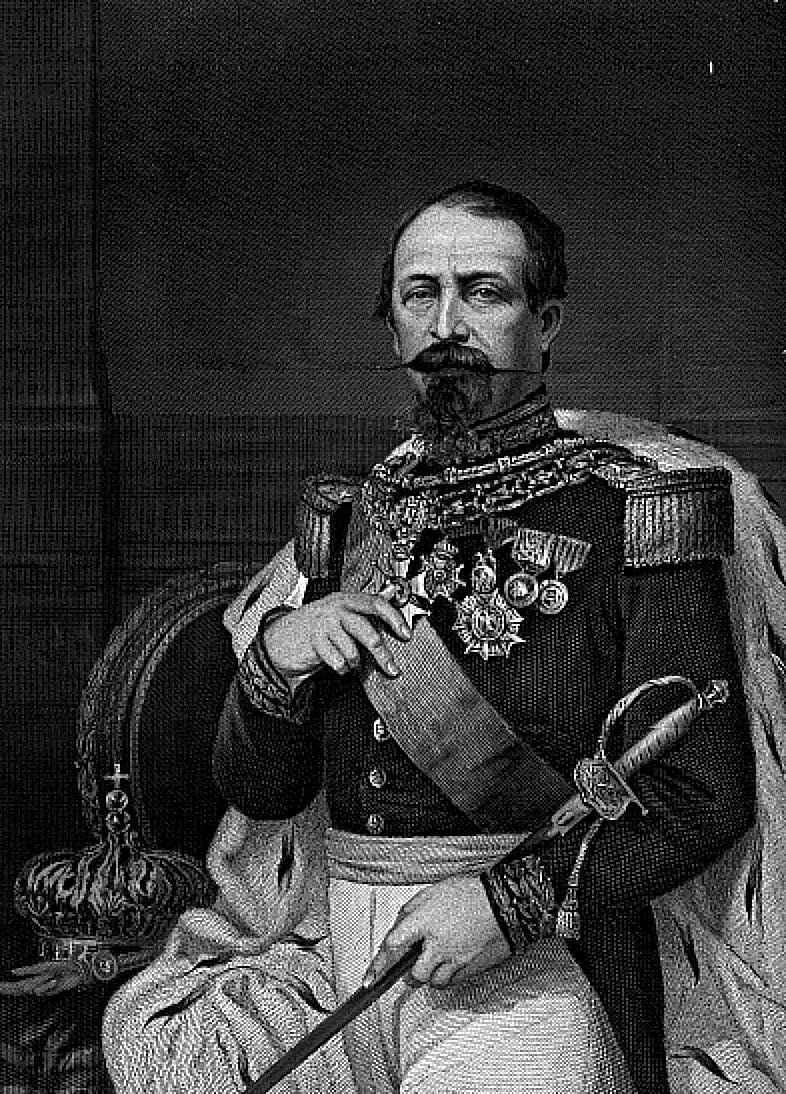 In 1858, Napoleon III had been in
power for ten years. France was experiencing extraordinary prosperity under the
Second Empire. Moneyed interests were very pleased with a robust stock market
and foreign investments paying rich dividends. Paris was receiving a face-lift
with broad boulevards and spacious parks. Les Invalides was becoming a national
shrine to military glory, the resting place of Napoleon I and museum housing
France’s martial treasures. Museums, restaurants, night life all bolstered the
reputation of the City of Lights. And in foreign adventures, the Second Empire
took France to the ends of the earth, glory bounding upon glory.
In 1858, Napoleon III had been in
power for ten years. France was experiencing extraordinary prosperity under the
Second Empire. Moneyed interests were very pleased with a robust stock market
and foreign investments paying rich dividends. Paris was receiving a face-lift
with broad boulevards and spacious parks. Les Invalides was becoming a national
shrine to military glory, the resting place of Napoleon I and museum housing
France’s martial treasures. Museums, restaurants, night life all bolstered the
reputation of the City of Lights. And in foreign adventures, the Second Empire
took France to the ends of the earth, glory bounding upon glory.
In 1858, Pope Pius IX had reigned
for twelve years. He had survived the Revolution of 1848, though his Secretary
of State Count Pellegrino Rossi did not. Revolutionaries and Italian
nationalists were kept at bay only with the aid of France. On July 3, 1849
French troops landed in Italy and afforded protection to the beleaguered
pontiff.
Political headaches aside, Pope
Pius IX had taken an unprecedented step on December 8, 1854 and promulgated the
definition of the Immaculate Conception, a doctrinal statement not made by a
Council but made ex cathedra, from the throne of Peter. Like the Marian
doctrine itself, this act of papal infallibility had widespread support
throughout the Church. It had been debated for centuries whether it was proper
for the Roman pontiff, the center of unity in the Church, the successor of the
First of the Apostles, Peter, to exercise such authority. While the majority
agreed with the concept of infallibility, a persistent minority either argued
against the doctrine or against its untimely application. The matter would be
settled at the First Vatican Council
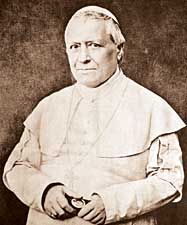 In INEFFABILIS DEUS Pius declared
“The most Blessed Virgin Mary was, from the first moment of her conception, by a
singular grace and privilege of almighty God and by virtue of the merits of
Jesus Christ, savior of the human race, preserved immune from all stain of
original sin.” As always, a Marian doctrine said more about the Son of God than
it did about the Mother of God. Mary’s holiness, which caused her to have an
immaculate conception, was wholly from Christ.
In INEFFABILIS DEUS Pius declared
“The most Blessed Virgin Mary was, from the first moment of her conception, by a
singular grace and privilege of almighty God and by virtue of the merits of
Jesus Christ, savior of the human race, preserved immune from all stain of
original sin.” As always, a Marian doctrine said more about the Son of God than
it did about the Mother of God. Mary’s holiness, which caused her to have an
immaculate conception, was wholly from Christ.
In 1858, the revelations of La
Salette were twelve years old. Thousands of pilgrims flocked to the site. In
1858, the visions of Catherine Laboure were twenty-eight years old and she
continued to live the private life of a Daughter of Charity even as millions of
Miraculous Medals were distributed.
February 11, 1858 proved to be a
cold, damp winter day in the foothills of the Pyrenees Mountains which separated
France from Spain. Three malnourished girls were in search of firewood. The
two Soubirous sisters were from a family so poor that it was common knowledge
they searched the town alleys for bones to take home and boil into a weak
broth. One the father was arrested for stealing food, but when the family’s
plight was made known to the police they let him go. On another occasion a
Soubirous boy stole into the village church and was caught eating the beeswax
candles, he was so hungry.
The Soubirous family had eight
children. They had no formal education. None could read or write.
During the February firewood
hunt, the fourteen year old Bernadette fell into a trance. She knelt down in
front of a small cave, an indentation in a sheer cliff. This alarmed her sister
and a friend who had gone out with them. They shook her violently and she came
out of the trance, telling the two girls she had seen a beautiful girl. On the
way back to the village of Lourdes the friend let out the secret and rumors flew
that Bernadette was crazy. Some accounts report that her mother beat her
because she brought attention to the family. When the local priest was told of
the vision, Father Peyramale ignored the whole affair.
Though Bernadette had been
forbidden to return to the site, she prevailed upon her father for permission.
Little French girls have a way with their fathers and his defenses crumbled.
She returned this time with nine other children, including her mischievous
friend. Again, Bernadette went into a trance before the little cave. Again,
the children panicked. The friend had climbed to the top of the cliff and threw
a large stone at Bernadette. It landed next to her but she was so intent on the
vision that she did not react. The children ran for help and a man helped carry
the stunned girl back to the village.
The next day Bernadette went
again to the spot. She asked the vision her name, but she only smiled and said
“it is not necessary.” Bernadette began calling her “Aquero,” patois of the
region meaning “That one.” In another vision, Bernadette reported, Aquero told
her “I don’t promise to make you happy in this world, but in the next.”
Word spread rapidly throughout
the region. Despite the rough terrain and lack of transportation crowds up to
eight thousand came from villages and towns nearby. The site of the apparition
was simply called The Grotto.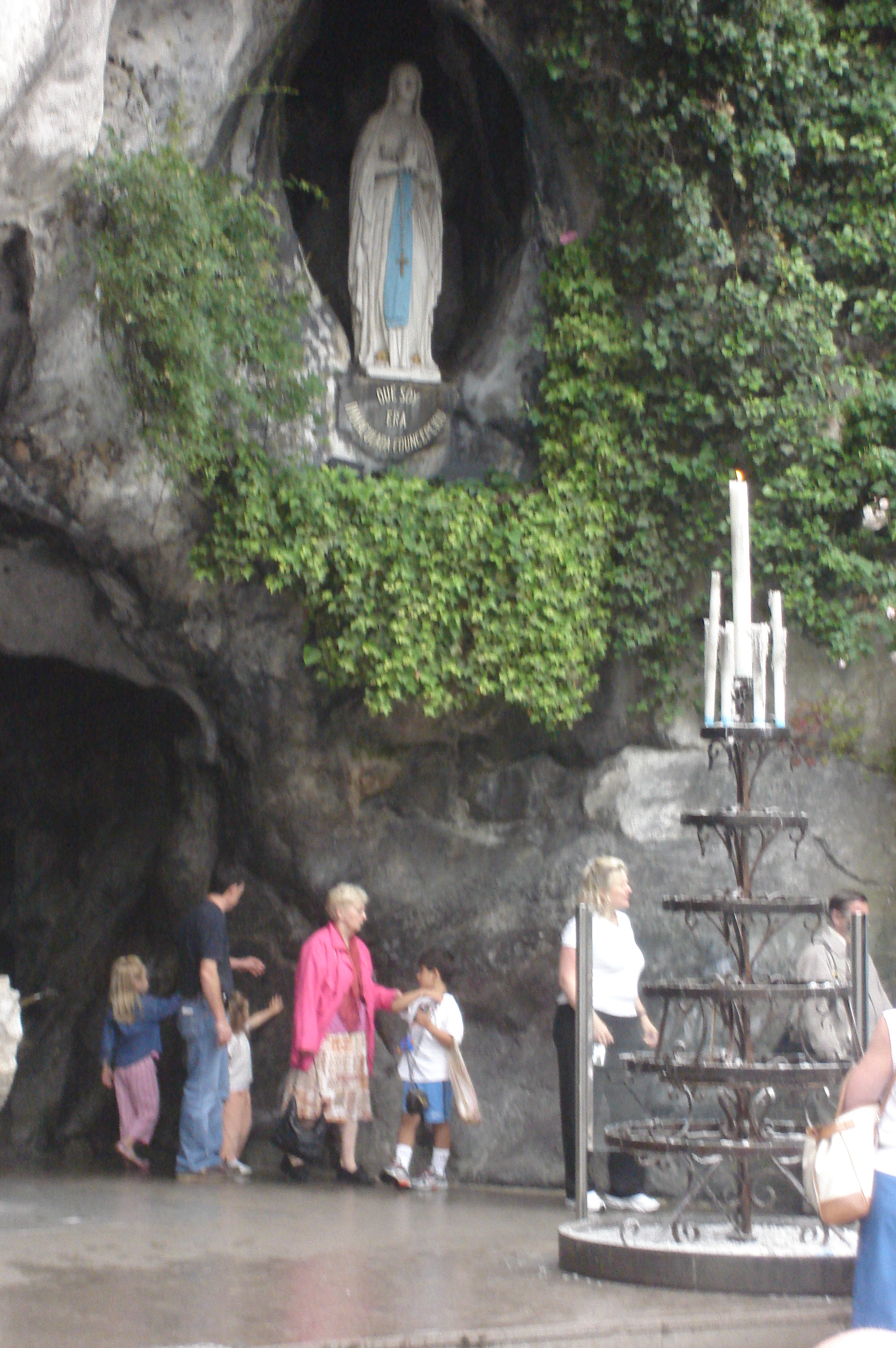
But there was opposition. Father
Peyramale was a no-nonsense priest who saved miracles for the Old and New
Testament. The local police commissioner Jacomet wanted nothing of this
either. Both interrogated Bernadette and were frustrated by her simplicity and
certitude. During one such interview at the home of the police commissioner,
crowds broke into the house to rescue the girl when the officer lost his temper
and began berating her.
Father Peyramale finally lost his
patience when, after the thirteenth apparition, on March 2, 1858, Bernadette
told him that Aquero wanted him to build a chapel. He demanded that Bernadette
get a name from Aquero, that he would do nothing without a name.
Further apparitions continued.
Further requests for a name were made by Bernadette. No name was forthcoming.
By now the crowds were ever-present and in large numbers. Many left small
statues and pictures at the site and others lit candles. The police feared for
the safety of the area.
And then one day, during a
trance, Bernadette got to her feet and approached the cave. The crowd fell
silent as they watched her kneel at the entrance to the cave and begin digging
in the dirty. After several handfuls of dirt, she brought up mud. She
continued to dig and the mud turned into dirty water. She took the mud and
smeared it on her face and then aid a bit of grass nearby. The crowds panicked,
but the waters continued to flow from the hole which now became a spring that
fed a stream into the Gave de Pau. From that day forward the spring continues
to produce around twenty-five gallons of pure water a day.
It was soon discovered that these
waters had extraordinary properties. A local day laborer, blinded due to a
degenerative disease, washed his eyes in the waters and was cured. The next
day, a local woman, Jeanne Crassus, washed her paralyzed hand in the waters and
was cured. Word spread and thousands of people made their way to the waters.
Police and soldiers were sent to control the crowds but more often than not,
they joined in the fray.
Bernadette was again at the site
on March 25th, the feast of the Annunciation. In her finest
etiquette she asked Aquero, “Madamoiselle, would you be so kind as to tell me
who you are, if you please?” Aquero laughed as she always did at the request.
But this time she smiled and told Bernadette.
The seer immediately came out of
her trance. She ran to the village of Lourdes, to the house of Father Peyramale,
barged in and stood before him. “Que soy era Immaculada Councepciou,” she
shouted in the patois of the region. “I am the Immaculate Conception.”
A final apparition took place on
July 16, 1858, the feast of Our Lady of Mount Carmel. Two years later
Bernadette would be sent to a school in Nevers to learn to read and write.
Thereafter she wrote an account of the events of 1858 at Lourdes. After four
years of schooling, Bernadette petitioned her teachers, the Sisters of Charity,
to accept her into the convent at Nevers. She received the name Sister Marie-Bernarde.
The sisters report that though Bernadette knew that Mary referred to herself as
The Immaculate Conception, the girl from Lourdes never understood the
theological meaning of the term. She simply accepted it on faith as she
accepted her role as a seer.
The bishop of Tarbes in whose
diocese Lourdes was located launched an investigation and declared in 1862 “We
are convinced that the apparition is supernatural and comes from God.”
It was hard to say otherwise.
Already by 1862 there were seven cases of miraculous cures which could not be
explained by the medical community. The waters caught the attention of the
Emperor himself when his son has suffered sunstroke during a vacation at
Biarritz. Within weeks of the last apparition of July 1858 an imperial
governess journeyed to Lourdes to interview Father Peyramale, who had become a
believer, and the seer Bernadette. She returned to the imperial family with a
jug of the miraculous waters and sprinkled them on the young prince for several
days. He recovered fully.
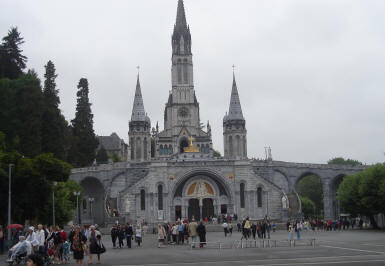 In October of that year Emperor
Napoleon III decreed that the barriers placed by the local Prefecture to keep
people away from the Grotto were to be removed. Later the former Finance
Minister of France, Achille Fould, bought an estate near Lourdes and convinced
Southern Rail Company to put a rail line in between Tarbes and Lourdes. Fould
encouraged trainloads of pilgrims to come to Lourdes. The poverty-stricken
village saw hotels, hostelries, restaurants, and shops. Tens of thousands
prayed at the Grotto and took the miraculous waters. Achille Fould was Jewish.
In October of that year Emperor
Napoleon III decreed that the barriers placed by the local Prefecture to keep
people away from the Grotto were to be removed. Later the former Finance
Minister of France, Achille Fould, bought an estate near Lourdes and convinced
Southern Rail Company to put a rail line in between Tarbes and Lourdes. Fould
encouraged trainloads of pilgrims to come to Lourdes. The poverty-stricken
village saw hotels, hostelries, restaurants, and shops. Tens of thousands
prayed at the Grotto and took the miraculous waters. Achille Fould was Jewish.
Mary’s prophesy to Bernadette
that life in this world would be hard proved to be true. She suffered from
asthma, tumors, bone diseases and tuberculosis, perhaps much of this brought on
by the extreme poverty of her youth. She was treated roughly by her superior,
Sister Marie-Terese Vauzau. Bernadette died at the age of thirty-five, two
years after the death of another seer and sister in another part of France,
Catherine Laboure. It was 1879. That same year, Lou Lou, the son of Emperor
Napoleon III, died at the age of twenty-one. He was speared to death fighting
for British interests in the Zulu Wars.
In 1909 the body of Bernadette
was exhumed. It was incorrupt. The sisters washed the corpse which caused a
discoloration. Wax was applied to hide the fault. In 1929 the body was again
exhumed. After forty-six years there was no corruption. A crystal reliquary
was set in the church of St. Gildard in Nevers where the body of Bernadette
Soubirous rests today. She was canonized on December 8, 1933, a day of grace
even as it was in a year of foreboding.
The date of December 8th
and the doctrine of the Immaculate Conception was a theme in French Catholic
history of the nineteenth century. It was proclaimed on millions of Miraculous
Medals through the Paris apparitions of 1830. Its promulgator, Pope Pius IX,
was given warning at La Salette in 1846. Mary identified herself with the title
at Lourdes in 1858. And when the emperor whose son had been cured by Lourdes’
waters stumbled into a disastrous war with Prussia, it was Mary who protected
the children at Pontmain, Brittany – what while a holy Spanish bishop who
founded an Order dedicated to the Immaculate Heart of Mary lay dying in a French
monastery.
Nineteenth century France was a
pell-mell mix of the lowest passions of hate and revenge, a residue of the
violence of the French Revolution and Counter-Revolution. But it was also home
to extraordinary grace and holiness. We have considered the lives of many of
the canonized saints of nineteenth century France. These were joined no doubt
by millions of others, peasants, artisans, aristocrats, lay, Religious, clergy
who lived quiet lives of holiness and devotion. They made pilgrimages, attended
Mass, wore the Miraculous Medal, prayed and lived lives given over to charitable
acts. Their stories will not be told in history books but in the Book of Life,
where it counts. And they can boast for all eternity that they lived too in a
land and in an age when the Blessed Virgin Mary walked among them.
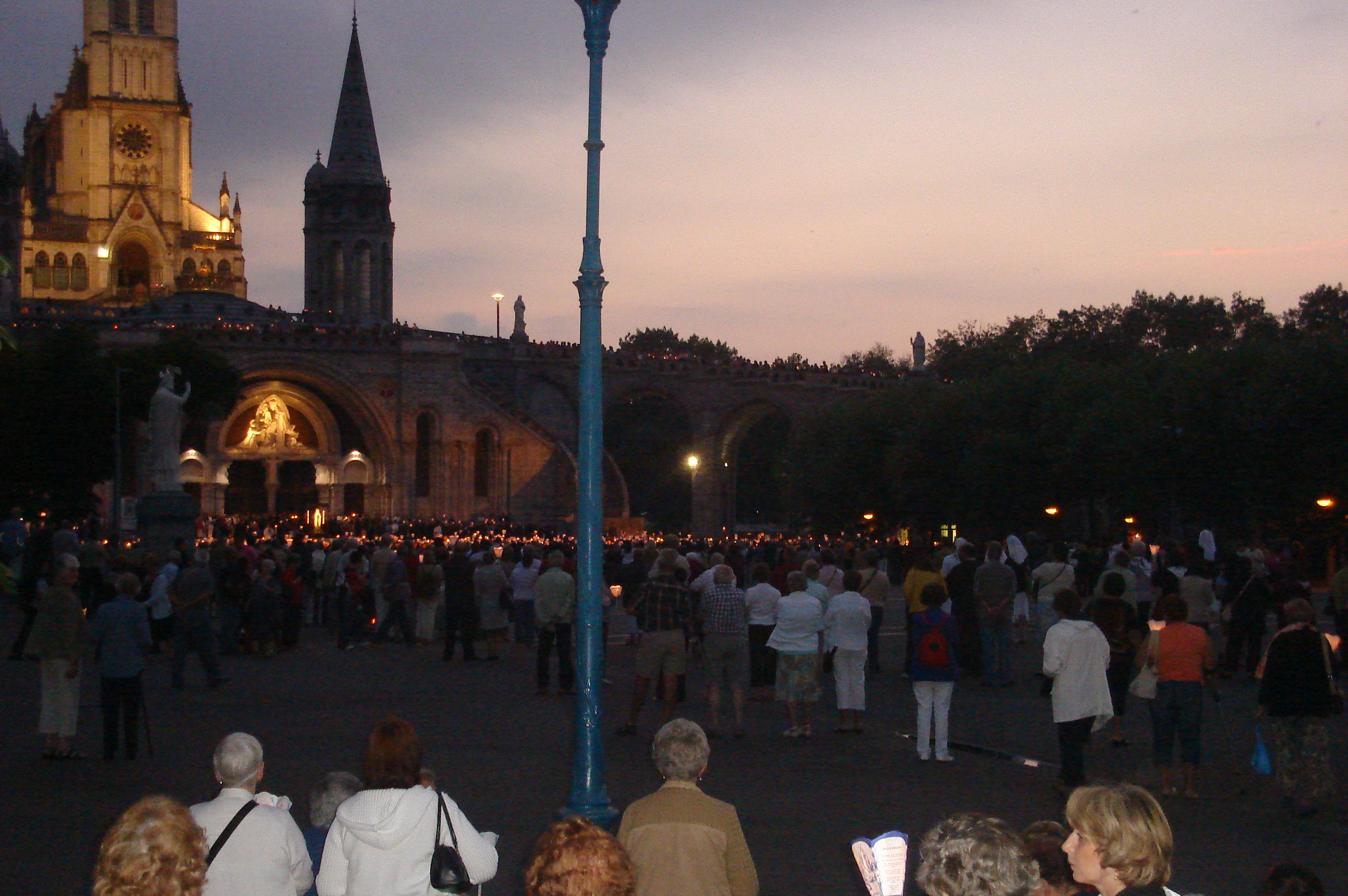
 In 1858, Napoleon III had been in
power for ten years. France was experiencing extraordinary prosperity under the
Second Empire. Moneyed interests were very pleased with a robust stock market
and foreign investments paying rich dividends. Paris was receiving a face-lift
with broad boulevards and spacious parks. Les Invalides was becoming a national
shrine to military glory, the resting place of Napoleon I and museum housing
France’s martial treasures. Museums, restaurants, night life all bolstered the
reputation of the City of Lights. And in foreign adventures, the Second Empire
took France to the ends of the earth, glory bounding upon glory.
In 1858, Napoleon III had been in
power for ten years. France was experiencing extraordinary prosperity under the
Second Empire. Moneyed interests were very pleased with a robust stock market
and foreign investments paying rich dividends. Paris was receiving a face-lift
with broad boulevards and spacious parks. Les Invalides was becoming a national
shrine to military glory, the resting place of Napoleon I and museum housing
France’s martial treasures. Museums, restaurants, night life all bolstered the
reputation of the City of Lights. And in foreign adventures, the Second Empire
took France to the ends of the earth, glory bounding upon glory. In INEFFABILIS DEUS Pius declared
“The most Blessed Virgin Mary was, from the first moment of her conception, by a
singular grace and privilege of almighty God and by virtue of the merits of
Jesus Christ, savior of the human race, preserved immune from all stain of
original sin.” As always, a Marian doctrine said more about the Son of God than
it did about the Mother of God. Mary’s holiness, which caused her to have an
immaculate conception, was wholly from Christ.
In INEFFABILIS DEUS Pius declared
“The most Blessed Virgin Mary was, from the first moment of her conception, by a
singular grace and privilege of almighty God and by virtue of the merits of
Jesus Christ, savior of the human race, preserved immune from all stain of
original sin.” As always, a Marian doctrine said more about the Son of God than
it did about the Mother of God. Mary’s holiness, which caused her to have an
immaculate conception, was wholly from Christ.
 In October of that year Emperor
Napoleon III decreed that the barriers placed by the local Prefecture to keep
people away from the Grotto were to be removed. Later the former Finance
Minister of France, Achille Fould, bought an estate near Lourdes and convinced
Southern Rail Company to put a rail line in between Tarbes and Lourdes. Fould
encouraged trainloads of pilgrims to come to Lourdes. The poverty-stricken
village saw hotels, hostelries, restaurants, and shops. Tens of thousands
prayed at the Grotto and took the miraculous waters. Achille Fould was Jewish.
In October of that year Emperor
Napoleon III decreed that the barriers placed by the local Prefecture to keep
people away from the Grotto were to be removed. Later the former Finance
Minister of France, Achille Fould, bought an estate near Lourdes and convinced
Southern Rail Company to put a rail line in between Tarbes and Lourdes. Fould
encouraged trainloads of pilgrims to come to Lourdes. The poverty-stricken
village saw hotels, hostelries, restaurants, and shops. Tens of thousands
prayed at the Grotto and took the miraculous waters. Achille Fould was Jewish.